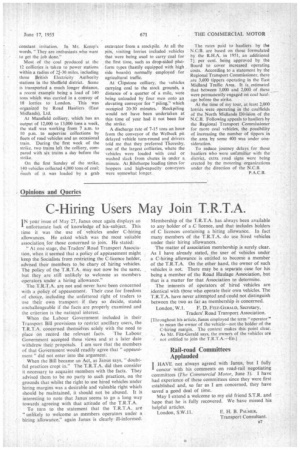Prodigious Efforts to Move Coal
Page 40

Page 41

If you've noticed an error in this article please click here to report it so we can fix it.
East Midland Hauliers and C-licensees Come to the Rescue of Consumers Affected by the Rail Strike
HAULIERS and C-licensees have been making prodigioui efforts to maintain deliveries of coal from the 12 collieries in No. 3 area of the National Coal Board. The pre-strike output of the area was over 200,000 tons of coal a weck, of which about 150,000 tons was transported by rail. When 1 visited the area last week, the amount carried by rail had . been reduced to around 25,000 tons a week, but the overall output had fallen only fractionally.
The remaining tonnage was being carried by road. .Even before the rail strike, 50.000-75,000 tons a week were transported by road. Approximately 5,000 tons was being transferred to stock grounds during the week, some of which was to be collected at the week-end by long-distance hauliers.
The collieries include Mansfield, Sherwood, Thoresby, Welbeck, WarsOp, Shirebrook, Bilsthorpe, Lidworth, Clipstone, Harworth, 011erton and Rufford. I visited Mansfield, Thoresby, Welbeck, Clipstone and Bilsthorpe. _ According to Mr. W. T. Kemp, chairman of the East Midland Area of the Road Haulage Association, and of Road Hauliers (East Midlands), Ltd., -the close liaison between the R.H.A., the Regional Transport Commissioner, Mr. A. C. Curtis, and representatives of the /*CB.. the British Transport Commission and various Ministries had enabled the number of tippers available for colliery work to be progressively increased and their operational efficiency to be maintained at a high level.
Judging by my' conversations with members of the pit staffs and vehicle drivers, and observation of tippers being loaded at the collieries, labour relations are excellent in the widest sense of the term. Only one complaint was heard; it came from the drivers of vehicles being loaded by conveyors.
Although the comparatively long time occupied by this method gives the drivers a well-earned respite without a monetary sacrifice, the delay causes u6 constant irritation. In Mr. Kemp's words, " They are enthusiasts who want to get the job done."
Most of the coal produced at the 12 collieries is taken to power stations within a radius of 4-30 miles, including three British Electricity Authority stations in the Sheffield district. Some is transported a much longer distance, a recent example being a load of 140 tons which was carried in a convoy of 18 lorries to London. This was organized by Road Hauliers (East Midlands), Ltd.
At Mansfield colliery, which has an output of 12,000 to 13,000 tons a week, the staff was working from 7 a.m. to 10 p.m. to supervise collections by fleets of road vehicles and an occasional train. During the first week of the strike, two trains left the colliery, compared with six trains a day before the strike.
On the first Sunday of the strike, 140 vehicles collected 4,000 tons of coal; much of it was loaded by a grab excavator from a stockpile. At all the pits, visiting lorries included vehicles that were being used to carry coal for the first time, such as drop-sided platform types (hastily equipped with high side boards) normally employed for agricultural traffic.
At Clipstonc colliery, the vehicles carrying coal to the stock grounds, a distance of a quarter of a mile, were being unloaded by four men onto an elevating conveyor for "piling," which occupied 20-30 minutes. Stockpiling would not have been undertaken at this time of year had it not been for the strike.
A discharge rate of 7-15 tons an hour from the conveyor of the Welbeck pit delayed vehicle turn-round and drivers told me that they preferred Thoresby, one of the largest collieries, where the vehicles were loaded with coal or washed slack from chutes in under a minute. At ,Bilsthorpe loading times for hoppers and high-capacity conveyors were somewhat longer. The rates paid to hauliers by the N.C.B. are based on those formulated by the R.H.A. in 1951, an additional 71 per cent. being approved by the Board to cover increased operating costs. According to a statement by the Regional Transport Commissioner, there are 3,600 tippers operating in the East Midland Traffic Area. It is estimated that between 1,000 and 2,006 of these_ were permanently engaged on coal haulage before the strike.
At the time of my tour, at least 2,000 lorrids were operating in the coalfields of the North Midlands Division of the N.C.B. Following appeals to hauliers by the Regional Transport Commissioner for more coal vehicles, the possibility of increasing the number of tippers in the area by some 400 was under consideration.
To reduce journey delays for those hauliers who were unfamiliar with the district, extra road signs were being erected by the motoring organizations under the direction of the N.C.B.
P.A.C.B.




























































































